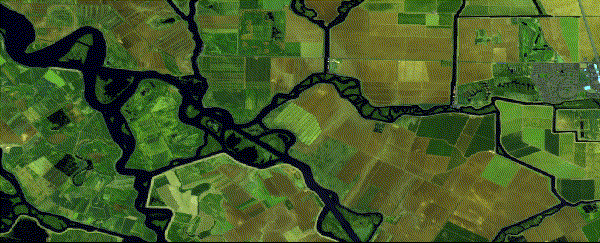Unlocking the Power of the Planet: How Google Earth Engine is Revolutionizing Remote Sensing
Source: NASA
The raw data is not enough. We’re drowning in data, but we’re thirsty for insights.
- Rebecca Moore, director of Google Earth
Google Earth Engine is a cloud-based platform that has revolutionized the remote sensing industry by providing access to petabytes of satellite imagery and geospatial data. With its sophisticated computing power and advanced algorithms, Google Earth Engine has made it possible to analyze and visualize complex environmental data at an unprecedented scale and speed.
Remote sensing is the process of collecting information about the Earth's surface using sensors on satellites, airplanes, or other platforms. This data can then be used to monitor environmental changes, such as deforestation, urbanization, and climate change. However, the processing and analysis of this data can be time-consuming and resource-intensive, making it difficult for researchers and conservationists to make timely decisions based on accurate information. Google Earth Engine solves this problem by providing a platform that allows users to access and analyze satellite imagery and other geospatial data without the need for expensive hardware or software. This allows researchers and conservationists to focus on analyzing the data rather than managing the computing resources.
Source: GIS and Beers
How Google Earth Engine is Changing the Game
Massive Data Storage and Processing Power
Google Earth Engine provides access to massive amounts of geospatial data and the computing power to process and analyze it. The platform hosts a vast collection of satellite imagery and other geospatial data that spans decades and covers the entire globe. The data is preprocessed and optimized for fast access and analysis, making it easy for users to perform complex analyses in a matter of hours or even minutes.
Advanced Algorithms and Tools
Google Earth Engine provides a wide range of tools and algorithms that allow users to perform advanced analyses on geospatial data. These include tools for image processing, feature extraction, classification, and time-series analysis. Users can also develop and deploy custom algorithms using the platform's scripting interface, which supports a wide range of programming languages.
Collaborative Environment
Google Earth Engine is a collaborative environment that allows users to share data, tools, and workflows. This enables researchers and conservationists to work together to solve complex environmental problems that require data from multiple sources or regions. Additionally, Google Earth Engine provides a platform for data sharing and collaboration across disciplines and organizations, helping to break down silos and promote interdisciplinary research.
Real-Time Monitoring
Google Earth Engine enables real-time monitoring of environmental changes, such as deforestation, urbanization, and climate change. Users can set up automated workflows that monitor changes in geospatial data and alert users to potential environmental threats or changes. This allows researchers and conservationists to respond quickly to emerging environmental challenges and take action to mitigate their impact.
Some examples—Real world GEE applications
Source: Ionescu Bogdan
Deforestation
Google Earth Engine has been used to monitor deforestation rates in the Amazon rainforest and other parts of the world. By analyzing satellite imagery over time, researchers can identify areas where trees have been cut down and quantify the extent of deforestation. This information can help governments and conservation organizations to develop and implement strategies to protect forests and mitigate the effects of deforestation.
Examples:
Monitoring temperate forest degradation on Google Earth Engine using Landsat time series analysis https://www.sciencedirect.com/science/article/abs/pii/S0034425721003680
Monitoring Forest Change in the Amazon Using Multi-Temporal Remote Sensing Data and Machine Learning Classification on Google Earth Engine https://www.mdpi.com/2220-9964/9/10/580
Urbanization
With the global population increasing and more people moving to cities, urbanization has become a major environmental challenge. Google Earth Engine has been used to map and monitor urban growth, including the expansion of informal settlements and slums. This information can help urban planners to identify areas of high population density and develop infrastructure and services to meet the needs of urban residents.
Examples:
Mapping Urbanization Trends in a Forested Landscape Using Google Earth Engine https://link.springer.com/article/10.1007/s41976-019-00020-y
Mapping Trajectories of Coastal Land Reclamation in Nine Deltaic Megacities using Google Earth Engine https://www.mdpi.com/2072-4292/11/22/2621
Climate change
Climate change is a complex and multifaceted problem that affects many different aspects of the environment, from sea level rise to changes in temperature and precipitation patterns. Google Earth Engine has been used to analyze and model various aspects of climate change, including the impact of melting glaciers and ice caps on sea level rise and the effects of drought on crop productivity. By providing data and tools for climate modeling and analysis, Google Earth Engine can help researchers and policymakers to better understand and mitigate the impacts of climate change.
Examples:
Timelapse: Melting Glaciers and Ice Caps https://earthengine.google.com/timelapse
Global drought monitoring with big geospatial datasets using Google Earth Engine https://link.springer.com/article/10.1007/s11356-020-12023-0
In conclusion, Google Earth Engine has revolutionized the remote sensing industry by providing a platform that enables access to vast amounts of geospatial data and the computing power to process and analyze it. This has made it possible to monitor and analyze complex environmental data at an unprecedented scale and speed, paving the way for more effective environmental management and conservation.


